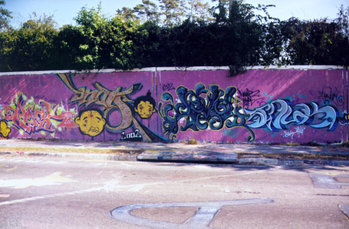
Aerosol or "spray can" art |
The strand of graffiti art which is considered one of the four elements of hip hop culture is usually denoted urban 'Aerosol Art'. Sometimes synonymous with "hip-hop heads," so-called graffiti artists have gone beyond that stereotype and are abundant even among middle-class white children. Different genres exist, from Philadelphia's wicked style to California and New York's wild style graffiti. Graffiti artists are classified based on their style and sometimes even on what surface they use.
One of the originators of New York graffiti, TAKI 183, a Greek-American foot messenger, would tag his nickname around New York streets that he daily frequented en route. His tag expressed a diminutive for Demetrius, while 183 came from his address. After The New York Times showcased him, hundreds of urban youth rapidly started mimicking his tag. Other active writers existed in New York City before Taki, such as JULIO 204, but an article about Taki in the New York Times brought attention to the movement. With the innovation of art, and the craving to gain the widest audience, taggers made attempts. There developed a preference for spray-paint (due to the fact that artists had to paint their art fast to evade police and security) and a strict adherence to spraypaint, sampling foreign calligraphy, and the much-anticipated mural (that usually covered an entire subway car). The graffiti vandal became a "writer," and groups of associated "writers" became "crews". The movement spread on the streets, returned to the railroads where hobos had popularized tagging, and spread nationwide with the aid of media and rap music; thus spurring imitation worldwide. New York City's "Lady Pink" became one of the earliest active women on the graffiti scene. Also known as Sandra Fabara, Lady Pink starred at the age of 18 in the classic 1982 hip-hop film Wildstyle. The 1984 film Beat Street documented all the elements and many of the personalities of the early hip-hop movement. Graffiti features strongly in the film, with one of the main characters a writer who works on walls and on subway cars. In the early 1980s, the combination of a booming art market and a renewed interest in painting resulted in the rise of a few graffiti artists to art-star status. Jean-Michel Basquiat, a former street-artist known by his "Samo" tag, and Keith Haring, a professionally-trained artist who adopted a graffiti style, became two of the most widely recognized graffiti artists. In some cases, the line between "simple" graffiti and unsanctioned works of public art can become blurred. |
© Copyright tagcltd.com All rights reserved. Unauthorized duplication in part or whole strictly prohibited by international copyright law. |
 Graffiti tagging existed in Philadelphia during the 1960s, pioneered by Cornbread and Cool Earl. Another Philadelphia product, Top Cat, later exported the characteristic Philly style of script (tall, slender lettering with platforms at the bottom) to New York, where it gained popularity as "Broadway Elegant". It wasn't until it reached popularity in the New York City Subway system that it took on an extravagant artistic role, expanding from tags to full-blown "pieces".
Graffiti tagging existed in Philadelphia during the 1960s, pioneered by Cornbread and Cool Earl. Another Philadelphia product, Top Cat, later exported the characteristic Philly style of script (tall, slender lettering with platforms at the bottom) to New York, where it gained popularity as "Broadway Elegant". It wasn't until it reached popularity in the New York City Subway system that it took on an extravagant artistic role, expanding from tags to full-blown "pieces".